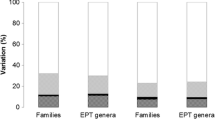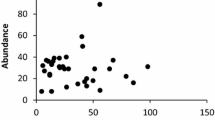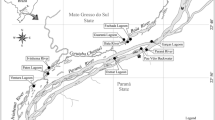Abstract
Eight mesohabitats, visually distinct units of habitat withinthestream, were sampled seasonally in a lowland chalkstreamreach. Theaim of the study was to test if mesohabitats defined asstructuralunits were inhabited by particular species assemblages and howthese varied with season. Classification (Bray-Curtisdissimilarityindex and UPGMA) and ordination analyses (DCA) of thedistributionof 258 species in 230 samples, were first used to check theagreement between the subjectively-selected mesohabitat andtheirassociated faunal assemblages. There was a goodcorrespondence, andmesohabitat samples were grouped into 5 major groups (Ranunculusin spring, silt, sand, gravel and macrophytes)whichwere further sub-divided to give a total of 11 groups whenseasonaldifferences were considered. Spearman rank correlation betweenthespatial distribution of mesohabitat groups with environmentalvariables revealed that water velocity and flow dynamicstogetherwith the nature of the substratum, influenced the distributionofthe benthic communities. To evaluate qualitative andquantitativedifferences in taxa composition among mesohabitats,informationstatistics tests and analyses of variance were used incombinationwith the Tukey honestly significant difference test. The 11groupswere characterised by abundance and frequency indicatorspecies.Inverse analysis of dominant species of the community showed agoodequivalence with mesohabitat groups and their indicatorspeciesobtained by direct analysis. The resulting species assemblagesrepresent faunal adaptation to the particular mesohabitats inrelation to natural environmental fluctuations. Themesohabitatscale provides a convenient structural ecological unit toexaminethe functional dynamics of faunal communities inrivers.
Similar content being viewed by others
References
Armitage, P. D., 1995. Faunal community change in response to flow manipulation. In Harper, D. M. & A. J. D. Ferguson (eds), The Ecological Basis for River Management. JohnWiley & Sons Ltd., Chichester: 59–78.
Armitage, P. D. & I. Pardo, 1995. Impact assessment of regulation at the reach level using macroinvertebrate information from mesohabitats. Regul. Rivers 10: 147–158.
Armitage, P. D., I. Pardo & A. Brown, 1995. Temporal constancy of faunal assemblages in ‘mesohabitats’. Application to management? Arch. Hydrobiol. 133: 367–387.
Barmuta, L. A., 1989. Habitat patchiness and macrobenthic community structure in an upland streamin temperateVictoria, Australia. Freshwat. Biol. 21: 223–236.
Boulton, A. J. & P. S. Lake, 1992. The ecology of two intermittent streams in Victoria, Australia. II. Comparisons of faunal composition between habitats, rivers and years. Freshwat. Biol. 27: 99–121.
Cummins, K. W. & G. H. Lauff, 1969. The influence of substrate particle size on the microdistribution of stream macrobenthos. Hydrobiologia 34: 145–181.
De March, B. G. E., 1976. Spatial and temporal patters in macrobenthic stream diversity. J. Fish. Res. Bd Can. 33: 1261–1270.
Davis, J. A. & L. A. Barmuta, 1989. An ecologically useful classifi-cation of mean and near-bed flows in streams and rivers. Freshwat. Biol. 21: 271–282.
Dawson, F. H., 1989. Ecology and Management of Water Plants in Lowland Streams. Annual Report, Freshwater Biological Association 57: 43–60.
Death, R. G. & M. J. Winterbourn, 1994. Environmental stability and community persistence: a multivariate perspective. J. N. am. Benthol. Soc. 13: 125–139.
Downes, B. J., P. S. Lake & E. S. G. Schreiber, 1993. Spatial variation in the distribution of stream invertebrates: implications of patchiness for models of community organisation. Freshwat. Biol. 30: 119–132.
Dudgeon, D., 1982. Aspects of the microdistribution of insect macrobenthos in a forest stream in Hong Kong. Arch. Hydrobiol. 2: 221–239.
Field, J. G., 1969. The use of the information statistic in the numerical classification of heterogeneous systems. J. Ecol. 57: 565–569.
Field, J. G., K. R. Clarke & R. M. Warwick, 1982. A practical strategy for analysing multispecies distribution patterns. Mar. Ecol. Prog. Ser. 8: 37–52.
Graça, M. A. S., D. M. Fonseca & S. T. Castro, 1989. The distribution of macroinvertebrate communities in two Portuguese rivers. Freshwat. Biol. 22: 297–308.
Hill, M. O., 1979. DECORANA–A FORTRAN program for detrended correspondence analysis and reciprocal averaging. Cornell University. Ithaca, New York, 52 pp.
Hosie, G. W. & T. G. Cochran, 1994. Mesoscale distribution patterns of macrozooplankton communities in Prydz Bay, Antarctica–January to February 1991. Mar. Ecol. Prog. Ser. 106: 21–39.
Hynes, H. B. N., 1970. The Ecology of Running Waters. University of Toronto Press, Toronto, 555 pp.
Kerans, B. L., J. R. Karr & S. A. Ahlstedt, 1992. Aquatic invertebrate assemblages: spatial and temporal differences among sampling protocols. J. N. am. Benthol. Soc. 11: 377–390.
Lamberti, G. A. & V. H. Resh, 1979. Substrate Relationships, Spatial Distribution Patterns, and Sampling Variability in a Stream caddisfly Population. Envir. Ent. 8: 561–567.
Lindegaard-Petersen, C., 1972. An ecological investigation of the Chironomidae (Diptera) from a Danish lowland stream (Linding A). Arch. Hydrobiol. 69: 465–507.
Lafont, M., 1983. Annélides oligochétes. Bulletin de la societé linneenne de Lyon 4: 108–135.
Mackay, R. J. & J. Kalff, 1968. Seasonal variation in standing crop and species diversity of insect communities in a small Quebec stream. Ecology 50: 101–109.
Marchant, R., P. Mitchell & R. Norris, 1984. Distribution of benthic invertebrates along a disturbed section of the La Trobe River, Victoria: and analysis based on numerical classification. Aust. J. mar. Freshwat. Res. 35: 355–374.
McAuliffe, J. R., 1984. Competition for space, disturbance, and the structure of a benthic stream community. Ecology 65: 894–908.
Minshall, G. W., 1984. Aquatic insect-substratum relationship. In Resh, V. H. & D. M. Rosemberg (eds), The Ecology of Aquatic Insects. Praeger Publishers, New York: 358–400.
Minshall, G. W. & J. N. Minshall, 1976. Microdistribution of benthic invertebrates in a rocky mountain (USA) stream. Hydrobiologia 55: 231–249.
Moon, H. P., 1939. Aspects of the ecology of aquatic insects. Trans. Soc. Brit. Ent. 6: 39–49.
Palmer, C. G., J. H. O’Keeffe & A. R. Palmer, 1991. Are macroinvertebrate assemblages in the Buffalo River, southern Africa, associated with particular biotopes? J. N. am. Benthol. Soc. 10: 349–357.
Peckarsky, B. L., 1979. Biological interactions as determinants of distributions of benthic invertebrates within the substrate of stony streams. Limnol. Oceanogr. 24: 59–68.
Pringle, C. M., R. J. Naiman, G. Bretschko, J. R. Karr, M. W. Oswood, J. R. Webster, R. L. Welcomme & M. J. Winterbourn, 1988. Patch dynamics in lotic systems: the stream as a mosaic. J. N. am. Benthol. Soc. 7: 503–524.
Rabeni, C. F. & K. E. Gibbs, 1980. Ordination of deep river invertebrate communities in relation to environmental variables. Hydrobiologia 74: 67–76.
Sedell, J. R., G. H. Reeves, F. R. Hauer, J. A. Stanford & C. P. Hawkins, 1990. Role of refugia in recovery from disturbances: modern fragmented and disconnected river systems. Envir Mgmt 14: 711–724.
Sheldon, A. L. & R. A. Haick, 1981. Habitat selection and association of stream insects: a multivariate analysis. Freshwat. Biol. 11: 395–403.
Southwood, T. R. E., 1988. Tactics. strategies and templets. Oikos 52: 3–18.
Tolkamp, H. H., 1980. Organism-substrate relationships in lowland streams. Agricultural Research Report 907, Agricultural University, Wageningen, The Netherlands, 211 pp.
Townsend, C. R., 1989. The patch dynamics concept of stream community ecology. J. N. am. Benthol. Soc. 8: 36–50.
Velimirov, B., J. G. Field, C. L. Griffiths & P. Zoutenkyk 1979. The ecology of kelp bed communities in the Benguela upwelling system. Analysis of biomass and spatial distribution. Helgoländer wiss. Meeresunters. 30: 495–518.
Verdonschot, P. F. M., 1984. The distribution of aquatic oligochaetes in the fenland area of N.W. Overijssel (The Netherlands). Hydrobiologia 115: 215–222.
Ward, J. V., 1992. Aquatic Insect Ecology. 1. Biology and Habitat. John Wiley & Sons, Inc. New York, 438 pp.
Author information
Authors and Affiliations
Rights and permissions
About this article
Cite this article
Pardo, I., Armitage, P.D. Species assemblages as descriptors of mesohabitats. Hydrobiologia 344, 111–128 (1997). https://doi.org/10.1023/A:1002958412237
Issue Date:
DOI: https://doi.org/10.1023/A:1002958412237




